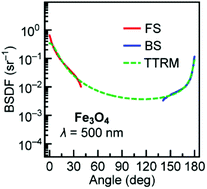A novel phase function describing light scattering of layers containing colloidal nanospheres†
Abstract
Light scattering from small particles exhibit unique angular scattering distributions, which are strongly dependent on the radius to wavelength ratio as well as the refractive index contrast between the particles and the surrounding medium. As the concentration of the particles increases, multiple scattering becomes important. This complicates the description of the angular scattering patterns, and in many cases one has to resort to empirical phase functions. We have measured the angle dependence of light scattering from a polymer layer containing sub-micron metallic and dielectric particles. The samples exhibited strongly forward and backward peaked scattering patterns, which were fitted to a number of empirical approximative phase functions. We found that a novel two-term Reynolds–McCormick (TTRM) phase function gave the best fit to the experimental data in all cases. The feasibility of the TTRM approach was further validated by good agreement with numerical simulations of Mie single scattering phase functions at various wavelengths and sizes, ranging from the Rayleigh scattering regime to the geometrical optics regime. Hence, the widely adaptable TTRM approach is able to describe angular scattering distributions of different kinds of nanospheres and nanocomposites, both in the single scattering and multiple scattering regimes.



 Please wait while we load your content...
Please wait while we load your content...